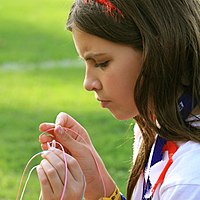
Photo from wikipedia
Successfully interpreting and navigating our natural visual environment requires us to track its dynamics constantly. Additionally, we focus our attention on behaviorally relevant stimuli to enhance their neural processing. Little… Click to show full abstract
Successfully interpreting and navigating our natural visual environment requires us to track its dynamics constantly. Additionally, we focus our attention on behaviorally relevant stimuli to enhance their neural processing. Little is known, however, about how sustained attention affects the ongoing tracking of stimuli with rich natural temporal dynamics. Here, we used MRI-informed source reconstructions of magnetoencephalography (MEG) data to map to what extent various cortical areas track concurrent continuous quasi-rhythmic visual stimulation. Further, we tested how top-down visuo-spatial attention influences this tracking process. Our bilaterally presented quasi-rhythmic stimuli covered a dynamic range of 4-20 Hz, subdivided into three distinct bands. As an experimental control, we also included strictly rhythmic stimulation (10 vs 12 Hz). Using a spectral measure of brain-stimulus coupling, we were able to track the neural processing of left vs. right stimuli independently, even while fluctuating within the same frequency range. The fidelity of neural tracking depended on the stimulation frequencies, decreasing for higher frequency bands. Both attended and non-attended stimuli were tracked beyond early visual cortices, in ventral and dorsal streams depending on the stimulus frequency. In general, tracking improved with the deployment of visuo-spatial attention to the stimulus location. Our results provide new insights into how human visual cortices process concurrent dynamic stimuli and provide a potential mechanism - namely increasing the temporal precision of tracking - for boosting the neural representation of attended input.
Journal Title: NeuroImage
Year Published: 2020
Link to full text (if available)
Share on Social Media: Sign Up to like & get
recommendations!